

A book of 1000 paintings and illustrations of robots created by artificial intelligence. The author generated all of the images in this book by writing original prompts for DALL·E 2, OpenAI’s AI system that can create realistic images and art from a description in natural language. Upon generating the images, the author curated and arranged the images to their own liking and takes ultimate responsibility for the content of this publication.
https://openai.com/dall-e-2/
https://github.com/CompVis/latent-diffusion
https://huggingface.co/spaces/multimodalart/latentdiffusion
https://mirror.xyz/0x0f6712c6ac4f02f47cA8b5cf200B224aE6fD8B69/AYLAsdtM090nHWpvWQ13exkaJoNyllkhxa9ffEUPOrg

Kid Pix just became pubic domain, so the remade (but pretty much exactly the same) version is now available here.
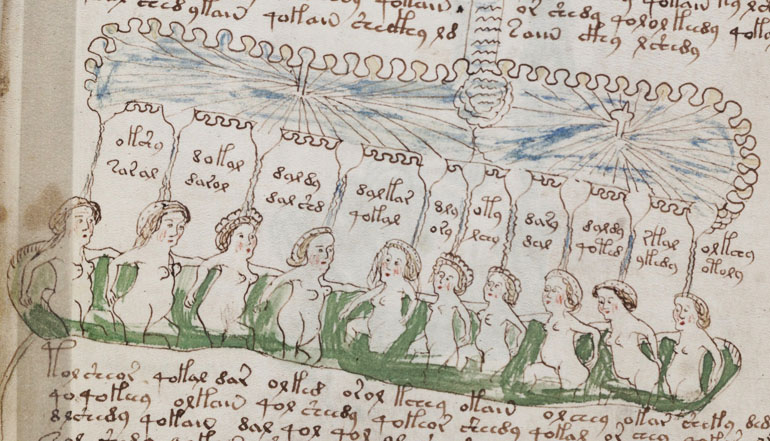
The Voynichese project (VP) defines a simple syntax for querying words in the Voynich Manuscript. While this syntax is only used internally, by the VP's query processor, it's important to be aware of how it operates in order to effectively query the manuscript.
Note that, unlike most query languages, Voynichese queries are evaluated at the word level. As such, word delimiters like whitespace and punctuation are not allowed.
Voynichese queries may use the following characters:
a,c,d,e,f,g,h,i,k,l,m,n,o,p,q,r,s,t,v,x,y,z,*,^,$
The characters a-z each match the corresponding EVA character.
The wildcard character "*" matches one or more EVA characters. Note that the wildcard may also be represented as a dash "-", for example when used in an URL.
The "^" character matches the start of a word.
The "$" character matches the end of a word.
For example, the query ^daiin$ will exactly match the EVA word daiin, whereas the query daiin (excluding the ^ and $ symbols) will match any EVA word containing daiin, such as chodaiindy.


Drawing Bot is a free, open source software for converting images to line drawings for Plotters / Drawing Machines / 3D printers. It also serves as an application for visual artists to create stylised line drawings from images / video.
It is available for Windows, Mac and Linux.
If you want to support the development of DrawingBotV3 you can donate here or contribute to the Drawing Bot Collection!
Features
15 Path Finding Algorithms - all highly configurable to create unique drawing styles
Automatic Path Optimisation for Faster Plots - Line Simplifying, Merging, Filtering, Sorting
Pen Settings: configurable colour / stroke width / distribution weight / blend modes - perfect for multi-layered plots.
Image Sequences: You can export image sequences animations of your creations!
Version Control: Save your favourite versions as you go and reload them.
Project Saving & Loading
60+ Image Filters for pre processing the imported image
Automated CMYK separation
Advanced User Interface with live drawing preview
User configurable Drawing Area, with Padding / Scaling Modes
Special pens for Original Colour/Grayscale Sampling
Presets: can be saved/imported/exported for sharing different styles with other users
Exports can be exported per/pen or per/drawing in multiple file types
Batch Processing: Convert entire folders of images automatically.
GCode - configurable Drawing Area, XYZ Offsets / Auto Homing.
vpype IntegrationPath Finding Modules
Sketch Lines PFM
Sketch Curves PFM
Sketch Squares PFM
Sketch Quad Beziers PFM
Sketch Cubic Beziers PFM
Sketch Catmull-Roms PFM
Sketch Shapes PFM
Sketch Sobel Edges PFM
Spiral PFM
Voronoi Circles
Voronoi Triangulation
Voronoi Stippling
Voronoi Diagram
Mosaic Rectangles
Mosaic VoronoiMore info here
Supported File Types
Import Formats:
Images: [.tif, .tga, .png, .jpg, .gif, .bmp, .jpeg]
Export Formats:
Vectors: [.svg, .pdf],
Images/Image Sequences: [.tif, .tga, .png, .jpg, .jpeg]
GCode: [.gcode, .txt],
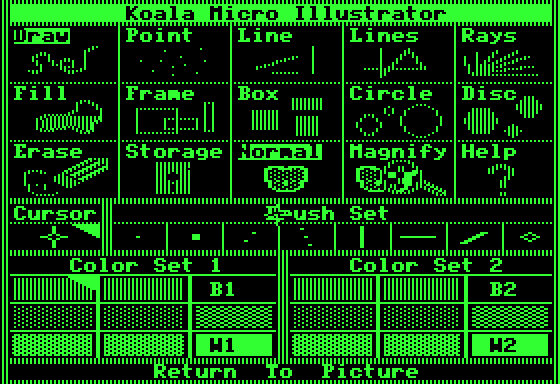
This timeline is the result of researching the origins of digital paint and draw software, and the tools that were developed to allow for hand manipulation (versus plotter drawn) drawing and painting - the mouse, light pen & drawing tablet. If we look at the software that has become commonplace today (such as adobe photoshop), which allows for painting, animation and photo manipulation in one, we can trace the roots of this software to the University and Corporate Labs that housed large computers with advanced capabilities for their time - MIT Lincoln Labs & Radiation Labs, DARPA & the Augmented Research Centre (ARC), Bell Labs, NYIT’s Computer Graphics Lab, Xerox Palo Alto Research Centre (Xerox PARC), NASA’s Jet Propulsion Labs (JPL). The artistic collaborations that grew out of these labs fueled the advent of Computer Graphics, Computer Art and Video Art from the 1960's to the 1990's.
This visual timeline starts by tracing the paint systems, frame buffers, and graphic user interfaces created out of these labs, with a focus on the first paint/draw software and the various drawing tools. I am interested in how the larger corporate, and often Military Funded laboratories, effected the dawn of the personal computer and the introduction of the personal computer to the home. This timeline continues through the 1980’s, with a focus on the software and hardware that was developed for the home market from late 1970's to the 1990's.
The Collections database consists of entries for more than 480,000 works in the Musée du Louvre and Musée National Eugène-Delacroix. Updated on a daily basis, it is the result of the continuous research and documentation efforts carried out by teams of experts from both museums.
🌑😄🌑🌑🌑🌑🌑🌑🌑🌑
🌑🌑🌑🌑🌑🌑🌑🌑🌑🌑
🌑🌑🌑🌓🌗🌓🌗🌑😄🌑
🌑🌑🌑🌓🌗🌓🌗🌑🌑🌑
🌑🌑🌑🌓🌕🌕🌗🌑🌑🌑
🌑😄🌑🌓🌗🌓🌗🌑🌑🌑
🌑🌑🌑🌓🌗🌓🌗🌑🌑🌑
🌑🌑🌑🌑🌑🌑🌑🌑🌑🌑
🌑🌑🌑🌑🌓🌗🌑🌑🌑🌑
🌑🌑🌑🌑🌓🌗🌑🌑😄🌑
🌑🌑🌑🌑🌓🌗🌑🌑🌑🌑
🌑😄🌑🌑🌓🌗🌑🌑🌑🌑
🌑🌑🌑🌑🌓🌗🌑🌑🌑🌑
🌑🌑🌑🌑🌑🌑🌑🌑🌑🌑





Conceptual comics is an archive of works that are unaffiliated with the commonly accepted history of the comics medium. It is a resonating chamber for conceptual works and unconventional practices that are little known outside of our community but also a springboard for establishing the conditions for an affective lineage between similarly minded practitioners. The variety of the collected material expresses the curator’s choice for a non uniform consistency and claim instead for a perpetual becoming of the medium. Nevertheless, these works share with each other many common issues and urgencies, alternating between material self-reflexivity and critical exhaustion. They operate on the margins of distribution and reception and their unlocatedness in the medium's spectrum is more than an abstraction: artists uncomfortable with the entrenched roles invite readers, in the absence of critical discourse, to engage with the works in non-specified, at times forensic, ways of examination. I argue that this condition, more than a minor drawback of a normative industry, induces new behaviours and forms of social relationships. Each of the works that are featured in this collection explores the very substrate of its medium not as a culturally neutral site, but as a way to build alternative historiographies, replete with its own material properties and signifying potentials. They propose to examine how social and economic forces and their related sets of activities and commercial, communicative and other routines compose the media’s meaning-signifying trajectory. The rainforest of pulp production, the printer’s studio, the readers’ column and the landfill are not simply the industry's geographies but are technologies of inscription in their own right. They are the integral elements of a material language that actively shapes the medium and challenges the reader to negotiate meaning through different distributions of transparency over opacity in its products. This collection proposes to equally embrace the real, the unclaimed, the anticipated and the fictional practices, in their constant materialisation, and reflect on their specific sites of production in their potential to register meaning and organise discourse based on the inscriptions of this material language.
About Ilan Manouach
Ilan David Manouach is a researcher and a multidisciplinary artist with a specific interest in conceptual and post-digital art. He currently holds a PhD position at the Aalto University in Helsinki (adv. Craig Dworkin) where he examines the intersections of contemporary graphic literature and XXIst century’s technological disruptions. He is mostly known for Shapereader, a system for tactile storytelling specifically designed for blind and partially sighted readers/makers of comics. He is also the founder and creative director of Applied Memetic an organization that researches the political repercussions of generative art and highlights the urgency for a new media-rich internet literacy. His work has been written about in Hyperallergic, World Literature Today, Wired, Le Monde, The Comics Journal, du9, 50 Watts and Kenneth Goldsmith’s Wasting Time on the Internet. For a fuller documentation on the above projects, the Brussels-based non-profit Echo Chamber is responsible for producing, fundraising, documenting and archiving Manouach’s research on contemporary comics, that has been presented in solo exhibitions to important festivals, museums and galleries worldwide. He is an Onassis Digital Fellow and a Kone alumnus and he works as a strategy consultant for the Onassis Foundation visibility through its newly founded publishing arm.
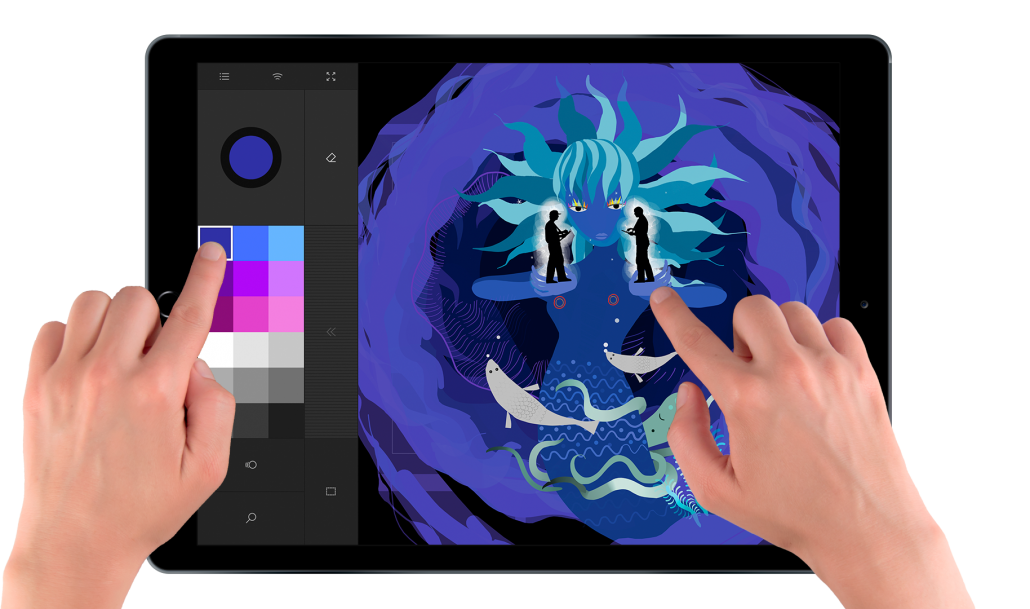

Paint and Animate Live!
Tagtool transforms your iPad into a visual live instrument. Paint with light, create animated graffiti or tell improvised stories.
https://www.tagtool.org/
https://bibliogram.art/u/tagtoolcrew
Strike is a web-based, 1-bit paint tool, primarily for quick sketching or line-drawing.
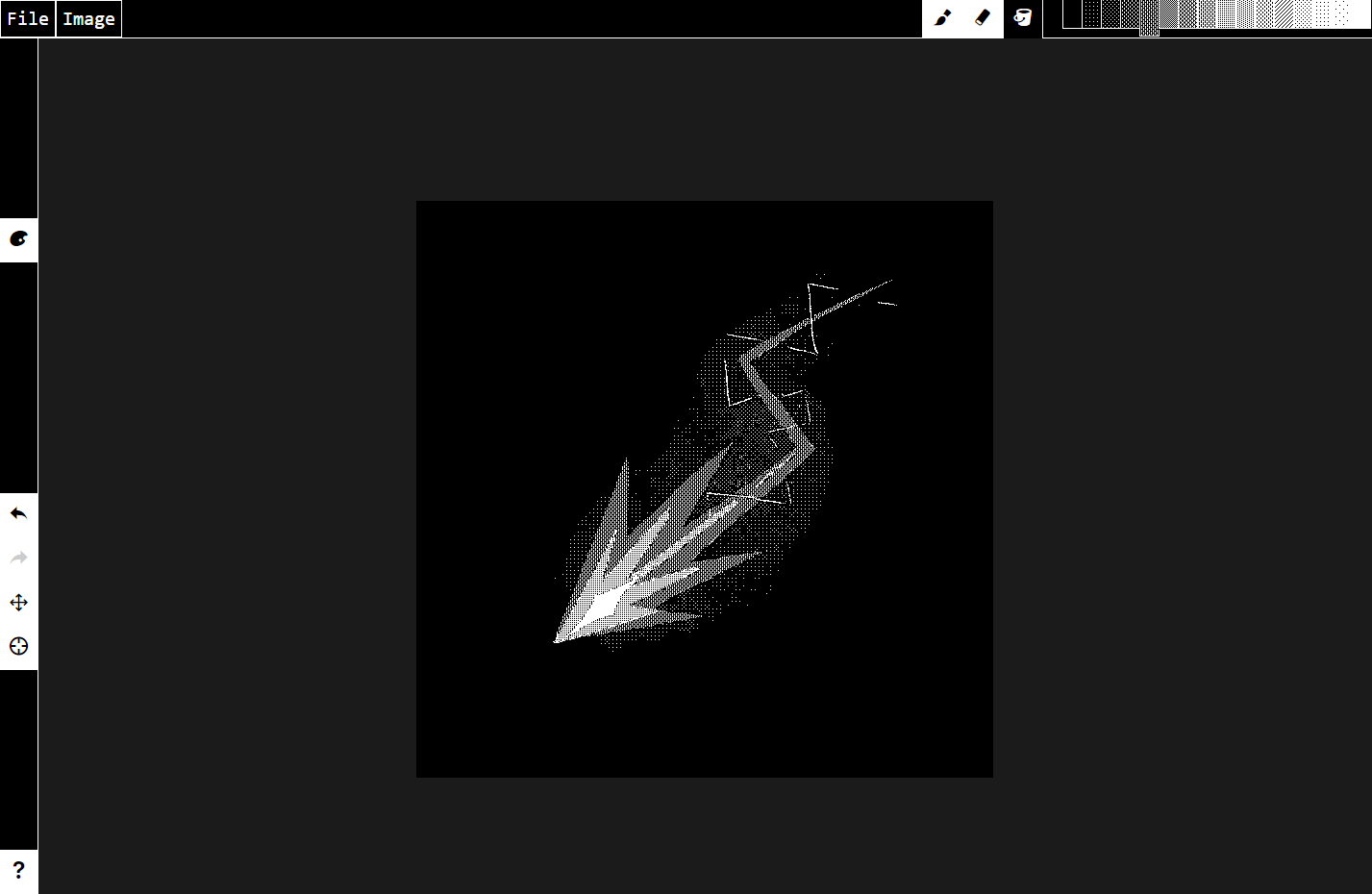
Features
brush / eraser / fill tools with different brush shapes and sizes
16-'color' palette via dither patterns. Each pattern is treated as a separate color for fill tool
~50 step undo / redo (it's fragile, so don't rely on it too much)
import PNG and JPG files, which will be converted to 1 bit form
zoom via mouse scroll or two-finger pinch
basic image transform tools (flip / mirror / resize canvas)
save images as a 16-color greyscale (which will import back into Strike with all patterns intact), or as 1-bit black and white image
autosave (see notes)Animation playground
We’d like to show you a new way to create hand-drawn animation. So playful you’ll think it’s a toy, but it's secretly a robust app with a reimagined UI for animators and creators.
Wonderfully musical
Taking inspiration from music creation tools, using Looom feels more like playing an instrument than operating software - exploring lines, shapes and colors through loopable time and rhythm.
Everyone in the loop
Looom is all about looping animation with a smile. It was designed for professionals and beginners of any age, and is already being used by some influential indie animators.
Welcome to Lospec, a home for digitally restrictive art. We create online tools for people creating pixel art and other restrictive digital art.

![]()
Digitally Restrictive Art
In the early days of computers, memory and storage space were a valuable commodity. Old hardware had very little space, every possible bit had to be conserved. Screen resolutions were small, and could only display a limited amount of colors. Music was stored as a sequence of notes rather than a single audio file. Games and programs had a maximum amount of space they could use, and they had to work within that restriction. Games made for the Atari 2600 could only be 32 kilobytes in total, including graphics, sounds, programming, levels.
Some people might view these restrictions as inconvenient, something that can only hinder your creative process. But there are many benefits to creating art within restrictions. Sometimes they simply help your get over art blocks by giving you a place to start, or help you use a consistent style throughout a piece. They can also force you to think in ways you might not have before and find creative ways to represent your vision. Your goal changes from "how can I best depict this subject" to "how can I best depict this subject within these limitations". You start thinking about the design, and level of detail. You are forced to simplify and prioritize, and consider the piece as a whole. It changes the whole creative process and forces you to think about your art from a new angle. The process of creating pixel art is completely different from even similar art forms like digital painting.
Some artists may impose restrictions upon themselves purposefully just to take advantage of these benefits. Some restrictions are just a result of that art form, like the canvas size of a painting or material of a sculpture. In Digitally Restrictive Art, the restrictions are brought on by the fact that they are stored digitally and is usually based on how the data is saved.
Pixel Art - The most popular digitally restrictive art form, as it was the only option for graphics on early video game systems. Though it's not required any longer, many games today still utilize pixel art due to it's aesthetic appeal, simplicity, and relative ease of creation. A large community of artists and fans still exists around the net.
Voxel Art - A more recent creation which is essentially a 3D version of pixel art. Instead of being made up of squares, it is made up of cubes. It's visuall similarity to pixel art makes it look like something out of the early computing days, but in reality only recently have computers been able to handle voxels.
Ascii Art - Similar to pixel art, but instead of being made up of pixels, everything is made up of ASCII characters, like letters and numbers. Before computers could even display pictures, artists could create images out of text. It was mostly notably adopted by the hacking community for use in text files.
Low-poly 3D - 3D models are typically made up of thousands of polygons, connected at their edges to create 3D shapes. In modern movies and games there are typically so many polygons that you can't see them and they look like a smooth surface. But in the early days of 3d, artists were limited to very few polygons. Low-poly models are still occasionally used in games today for memory restrictions as well as aesthetics. A subset of low-poly 3D includes using pixel art for the textures, adding another layer of restrictions.
Chiptune - Storing audio digitally actually takes quite a bit of space. Rather than reducing the length or quality of a song, early digital composers created a way to store songs as notes, which are then played at specified times, essentially being performed live by the computer. There are many different formats of digitally restrictive music that offer a whole array of different features and sounds. Midi files for example have a preset group of instruments you can assign to each note, and MOD/XM files let you create your own instruments out of waveforms.
REXPaint is a powerful and user-friendly ASCII art editor. Use a wide variety of tools to create ANSI block/line art, roguelike mockups and maps, UI layouts, and for other game development needs. Originally an in-house dev tool used by Grid Sage Games for traditional roguelike development, this software has been made available to other developers and artists free of charge. While core functionality and tons of features already exist, occasional updates are known to happen.

With Multipaint, you can draw pictures with the color limitations of some typical 8-bit computer platforms. The screen formats supported are Commodore 64 high resolution, Commodore 64 multicolor, Commodore Plus/4 Hires, Commodore Plus/4 multicolor, ZX Spectrum, MSX 1 and Amstrad CPC0.
Multipaint features common drawing tools, color clash emulation, cut brushes, dither patterns, grid / snap, 20-step undo, spare page, magnify modes, direct executable export, export as source, import/export in native formats and much more.


http://www.mtmad.fr
Musée des Tissus et musée des Arts décoratifs,
Lyon - France
A painstaking investigation of Europe’s cave art has revealed 32 shapes and lines that crop up again and again and could be the world’s oldest code.


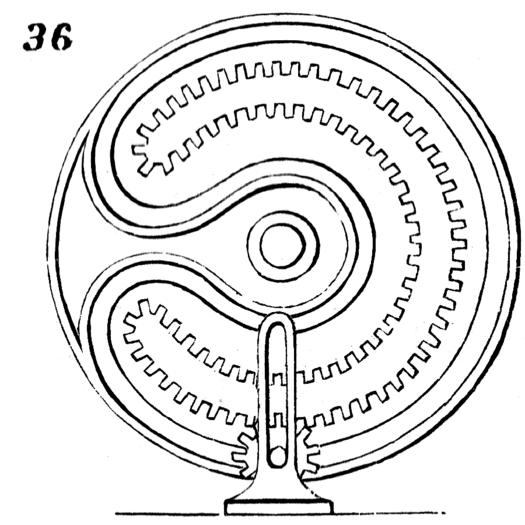
This is an online edition of the classic technical reference Five Hundred and Seven Mechanical Movements by Henry T. Brown.
This site contains the original illustrations and text from the 21st edition of the book, published in 1908. It also includes animated versions of the illustrations, and occasional notes by the webmaster.
The animated versions are not yet complete. They are identified by color images in the thumbnail pages.
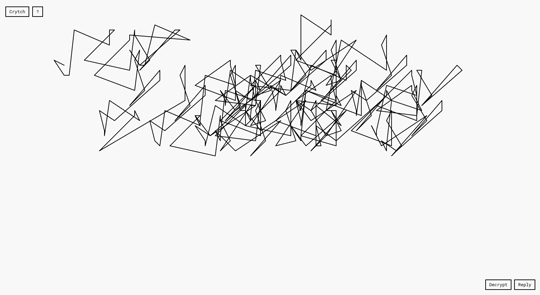
Crytch is a web tool for creating and encrypting visual messages.
It transfers the idea of Visual Cryptography to letters and shapes consisting of multiple anchor points and connecting lines. As soon as one begins to enter a password, these points start moving on a variable matrix. That way, the password will never be stored on the server.
The correctly decrypted image is the only possible verification of a valid password. Thus, the exact point at which the original image is revealed can solely be determined by a human observer.
All text messages are displayed in a typeface specifically designed for Crytch. In order to make it impossible to deduce the encrypted letter just by counting its anchor points, all glyphs consist of the exact same amount.
https://github.com/sirxemic/fractal-paint
Online little tool to create fractal-ish images from simple drawings using HTML5 canvases.
Outpost of the 'Art of Akira' exhibit, featuring original production art used in the creation of Katsuhiro Otomo's 'Akira' (1988).
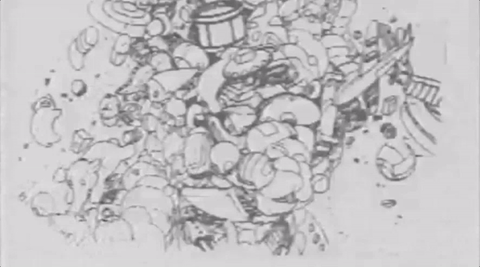
PabloDraw is an Ansi/Ascii text and RIPscrip vector graphic art editor/viewer with multi-user capabilities.

We are the best site for downloading FREE public domain Golden Age Comics. All files here have been researched by our staff and users to make sure they are copyright free and in the public domain. To start downloading just register an account and enjoy these great comic books. We do not charge per download and the goal of the project is to archive these comic books online and make them widely available.
GrafX2 is a bitmap paint program inspired by the Amiga programs Deluxe Paint and Brilliance. Specialized in 256-color drawing, it includes a very large number of tools and effects that make it particularly suitable for pixel art, game graphics, and generally any detailed graphics painted with a mouse. The program is mostly developed on Linux and Windows, but is also portable on many other platforms. 
These drawings are a methodical interpretation of A Thousand Plateaus: Capitalism and Schzophrenia by Gilles Deleuze and Felix Guattari.
Recursive Drawing is an exploration of user interface ideas towards the development of a spatially-oriented programming environment.
Recursive Drawing is by Toby Schachman for his ITP thesis project Alternative Programming Interfaces for Alternative Programmers.
Drag this bookmarklet to your bookmarks bar.
You need Firefox or Chrome to use goggles.
Activate on any webpage.
Draw with the left mouse button.Erase with the right mouse button.
Polish drawer who do satirical illustration.
Generative drawing dream.
The drawings below are a methodical interpretation of the first two chapters of A Thousand Plateaux : Capitalism and Schizophrenia by Gilles Deleuze and Felix Guattari.
The Hand Drawn Map Association (HDMA) is an ongoing archive of user submitted maps and other interesting diagrams created by hand.
Let's get flurrious, create snowflakes..
Artiste en arts visuels
Draw from your browser sketchy, shaded, chrome, fur, long fur and web style.
Draw with Japanese characters